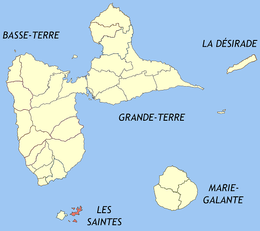Terre-de-Haut Island
| Native name: <span class="nickname" ">Terre-de-Haut des Saintes | |
|---|---|
 Terre-de-Haut view from Chameau hill. | |
 | |
| Geography | |
| Location | Caribbean sea |
| Coordinates | 15°51′45″N 61°35′00″W / 15.86250°N 61.58333°WCoordinates: 15°51′45″N 61°35′00″W / 15.86250°N 61.58333°W |
| Archipelago | Îles des Saintes |
| Total islands | 9 |
| Major islands | Terre-de-Bas Island |
| Area | 5.2 km2 (2.0 sq mi) |
| Highest elevation | 306 m (1,004 ft) |
| Highest point | Chameau hill |
| Administration | |
| Overseas department | Guadeloupe |
| Canton | les Saintes |
| commune | Terre-de-Haut |
| Capital city | Fond-du-Curé |
| Largest settlement | Fond-du-Curé |
| Mayor | Louis Molinié |
| Demographics | |
| Population | 1838 (2006) |
| Pop. density | 352 /km2 (912 /sq mi) |
Terre-de-Haut Island (officially in French :Terre-de-Haut des Saintes (literally: highland of les Saintes)) is an island in the Îles des Saintes archipelago, in the Lesser Antilles. It belongs to the commune (municipality) of Terre-de-Haut into the French department of Guadeloupe.
Geography
Description
Terre-de-Haut island is the most easterly island of the archipelago of les Saintes. Like its neighbour Terre-de-Bas, it holds its name from the maritime vocabulary which called the islands exposed to the wind highland and those protected from the wind, lowlands. It is an island of 5.2 km2 (2.0 sq mi) dominated in the north by Morne Mire hill (107 metres (351 ft)) and Morel hill (136 metres (446 ft)) and in the South by Chameau hill 306 metres (1,004 ft), the highest mount of the island and the entire archipelago. Terre-de-Haut is separated from Terre-de-Bas by a narrow channel of 890 m (0.55 mi). Besides Terre-de-Bas, several small islands surround Terre-de-Haut:
The Pain de sucre peninsula, with the height of (53 metres (174 ft)) is linked to Terre-de-Haut by an isthmus.[1]
Populated areas
Small villages are seen spread out in the rolling hills in the interior. Fond-du-Curé is located in a natural harbour. Yachts and cruise boats are a common sight in the harbour. The oldest settlements still remaining are the villages of Mouillage and Fond-du curé.[2] The population is spread among 20 quartiers (districts), more or less well delimited. They are grouped into two halves:[3]
| Au vent (Windward) |
Sous le Vent (Leeward) | ||
|---|---|---|---|
| Nr | Quartier | Nr | Quartier |
| 1 2 3 4 5 6 7 8 9 10 |
Pompierre Marigot Vieille-Anse Fort Napoléon Maison blanche la Coulée Coquelet Anse-Mire Mouillage Grande-Anse |
11 12 13 14 15 16 17 18 19 20 |
Fond-du-Curé la Savane Anse Rodrigue Anse Galet Prés Cassin la Convalescence Anse Figuier Pain de sucre Anse à Cointe Anse Crawen |
The local vocabulary says: "to go up" to move towards the windward quartier (to Fort Napoléon) and "to go down" to move towards the leeward quartier (to Pain-de-sucre).
Demography
The inhospitable relief and the low precipitation do not allow the establishment of agriculture. Few slaves were brought onto these islands. The population is constituted historically by Bretons, Normans and by inhabitants of Poitou who settled down to fish. This explains the European type of the people from les Saintes (Saintois) French: [sɛ̃twa] (French gentilic of the inhabitants of les Saintes).
In 2006 the population of Terre-de-Haut was 1,838, with a density of population of 306 inhabitants/km2. The number of households was 693.[4]
Climate
Language
History
Culture
Economy
The island lives essentially on fishing and tourism. The island contains a UCPA center with 60 bungalows, and receives approximately 120 trainees every week. it closes for two months every year because of the weather conditions.
Environment
Transport
To see
- The bay of les Saintes
- The museum and the botanical garden of Napoleon fort
- The natural reserves of Chameau and Morel hill
- The Caroline Artillery battery on Morel hill and Modele Tower on Chameau hill
- The French navy cemetery of Terre-de-Haut
- The lighthouse of the Port of Terre-de-Haut.
- The Bateau des îles (the house in the shape of bow of a ship)
- The chapel of the Calvary
- The square of the Governor Lion or square of the port, with its colored houses.
- The organs pipes of basalt of Pain de sucre
- Notre Dame de l'Assomption's church
- The multiple beaches (Anse Crawen, Pompierre, Anse Rodrigue, Anse Figuier, Marigot beach, Anse Mire, Grande-Anse, Vieille Anse, Anse à Cointre, and Pain de Sucre)
See also
References
- ↑ "Monographie sur les Saintes (dépendance de la Guadeloupe)". gallica.bnf.fr. Retrieved 2014-10-10.
- ↑ Bonniol, J.L. (1980). Terre-de-Haut des Saintes: contraintes insulaires et particularisme ethnique dans la Caraïbe. L HARMATTAN. p. 299. ISBN 9782903033132. Retrieved 2014-10-10.
- ↑ "Au bourg débute la visite de Terre de Haut". escale-creole.wifeo.com. Retrieved 2014-10-10.
- ↑ "Insee - Chiffres clés : Commune de Terre-de-Haut (97131)". statistiques-locales.insee.fr. Retrieved 2014-10-10.